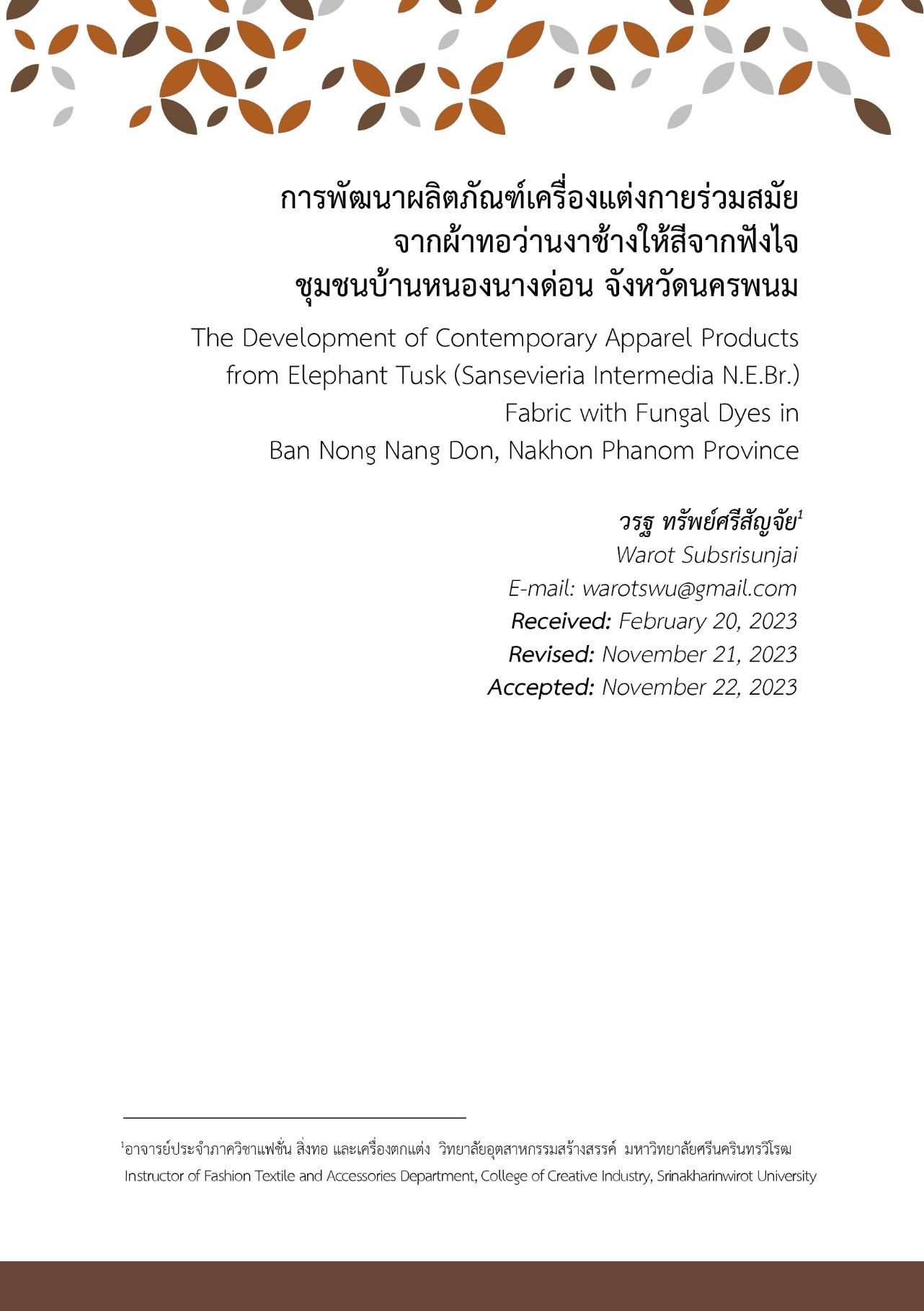The Development of Contemporary Apparel Products from Elephant Tusk (Sansevieria Intermedia N.E.Br.) Fabric with Fungal Dyes in Ban Nong Nang Don, Nakhon Phanom Province การพัฒนาผลิตภัณฑ์เครื่องแต่งกายร่วมสมัยจากผ้าทอว่านงาช้างให้สีจากฟังไจ ชุมชนบ้านหนองนางด่อน จังหวัดนครพนม
Main Article Content
Abstract
The research titled “The development of contemporary apparel products from elephant tusk (Sansevieria intermedia N.E.Br.) fabric with fungal dyes in Ban Nong Nang Don, Nakhon Phanom Province” aims to 1) develop unique fabric patterns that reflect local identity, 2) analyze how to add value to the fabric by turning it into a contemporary apparel, and 3) propose ways to increase the community's self-reliance capacity, create job opportunities and generate income for the local community. The research method is divided into 5 phases: 1) study community context information and analyze the data, 2) design local identity patterns, 3) find ways to create added value by analyzing and comparing with products on the market, 4) produce prototypes of contemporary clothing products by creating and developing product styles, developing collections of clothing for men and women, and 5) analyze the data on the methods for increasing the woven fabric. The results of the research reveal the following: 1. The design of elephant tusk woven fabric should have a variety of elements because there are other similar handwoven fabrics in the market, making them easy to imitate. Therefore, the design of Ban Nong Nang Don's unique woven fabric has three components: 1.1) a set of patterns from the design of the fabric pattern based on the environment, stories and traditions of Ban Nong Nang Don community. There are 3 Mudmee patterns obtained from the identity of the community: 1.1.1) Luk Yang Na pattern, 1.1.2) Wasp pattern, 1.1.3) White eel pattern. These patterns are combined with Mudmee patterns and weaving techniques; 1.2) Fiber composition comprises cotton yarn mixed with elephant tusks fibers woven with a technique of intermittently inserting special weft threads to create a texture on the fabric; 1.3) Dye set is from dyeing with natural dyes from materials found in the village and dyes obtained from fungal using 3 colors: yellow, gray-brown, and pink, creating an identity of the community. 2) There are 4 methods for increasing the value of elephant tusk woven fabric: 2.1) Patterns and weaving structure techniques, 2.2) Colors and dyeing techniques, 2.3) Woven material fibers, and 2.4) Product processing by trial production of a contemporary clothing collection, consisting of 20 pieces of clothing and accessories for men and women in the target group of working-age consumers. 3) The guidelines for increasing community capacity include 3.1) The production process should be self-reliant using raw materials and wisdom from the environment in the community mixed with textile innovations, 3.2) The products should cater to current fashion, 3.3) The production should be made into collections, and 3.4) The product design should follow the popularity of the target group of working age consumers (Gen Y).
Downloads
Article Details

This work is licensed under a Creative Commons Attribution-NonCommercial-NoDerivatives 4.0 International License.
References
Boonla, S. (2010). Knowledge of weaving fabrics. Bangkok: Vista Interprint.
Chimpanao, P. (2008). Design of Weaving Patterns by Computer Program. Chiang Mai: Wanida Printing.
Diewwanit, W. (2015). Study and development of patterned structure of hand-woven hemp-fiber blended silk fabric for Ladies' wear. (Master’s Thesis). Srinakharinwirot University, Bangkok.
Hiranpruek, W. (2014). Sustainable fashion. New attitudes towards adapting Thai fashion. Bangkok: Textile Institute.
Office of the Permanent Secretary, Ministry of Culture. (2022). Garment art from local to international by the Ministry of Culture. Bangkok: Printing Office Veterans Welfare Organization under the royal patronage.
Setthakriengkrai, A. (2013). Green Textile Innovation. Bangkok: Office of Industrial Management.
Somnuk Sangnu, S. (2005). Fabric structure and properties. Bangkok: Rajamangala University of Technology Thanyaburi Faculty of Engineering Department of Textile Engineering.
Subsrisunjai, W. (2015). Fashion design identity by using the brand archetype concept. (Doctoral Dissertation). Faculty of Fine and Applied Arts Chulalongkorn University, Bangkok.
Teerakul, S. (2015). The study and development of Eri-silk textile construction for fashion case study of Tuck Tor Mai Eri Cluster, BanRai District. (Master’s Thesis). Srinakharinwirot University, Bangkok.
WangYang Subdistrict Administrative Organization (n.d.). Retrieved from https://www.wangyang-sao.go.th


